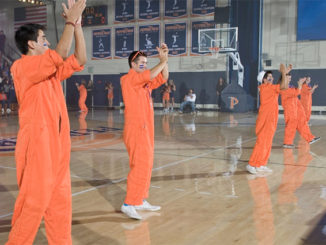
Does technology in class help or hinder? That is the question.
Technology can improve the organization, efficiency and interactiveness of the classroom experience. However, it can also be a distraction, luring students onto social media sites instead of listening to the lecture. Professors and staff are working to make the best use of technology.
“Technology is very much like a double-edged sword,” Communications Tech Liaison Lance Coert said. “Some students, it’s going to benefit them quite a bit, other students it’s going to get in the way. This is where professors have to make sure that when they are using technology they keep the students engaged the entire time.”
It is inevitable to see students on phones, laptops or tablets all around campus, but one can never be sure of whether they are doing homework or simply updating a Facebook status. Professors are trying to take advantage of social networking trends among college students.
Experts such as Coert and Chief Information Officer Jonathan See agree that technology should foster engagement and connection with students. It should be used to make the lecture material more relatable.
A spring 2014 poll found that 37 of 52 respondents think that professors use technology efficiently in the classroom. This includes the use of Facebook, Twitter and PollEverywhere. Some 83 percent of students reported their professors use Courses. The majority of students surveyed said their personal use of technology in the classroom is helping their ability to learn.
University officials said they have been trying to play catch up as technology rapidly changes.
Pepperdine has slowly progressed from professors rarely using PowerPoint and not having an academic hub such as Sakai, to the use of several applications such as Panopto, Poll Everywhere, the Pepperdine mobile app and Courses, along with the integration of social media and Internet use in the classroom.
Religion and Social Science Tech Liaison Christopher Low said that when he started working for Pepperdine eight years ago, some professors weren’t even using PowerPoint. Now all classrooms have classroom computers.
“I don’t think that Pepperdine is a trendsetter when it comes to technology, but I don’t think necessarily that that’s a bad thing,” Communication Professor Caitlin Lawrence said. “I think sometimes people are quick to adopt technology because it’s new and trending, but it’s not always practical to use in the classroom.”
As university officials have been upgrading the technology on campus, most students are investing in multiple devices to stay connected.
“I’ve been here for 11 years,” Religion Professor Christopher Heard said. “I’ve seen the classroom go from students having no laptops to being lit up with them.”
Most professors are embracing the technological changes.
“I use PowerPoint, YouTube videos, my own iPad to keep my notes, so I am heavily reliant on technology,” Psychology and Statistics Professor Linka Griswold said. “I upload all my supplementary materials, and for statistics I upload all my data sets through Sakai.”
Distractions, however, abound.
“I think that overall it can enhance student learning, but what I have noticed is that students tend to go on Facebook during class lecture and in that sense it can hinder student learning,” Griswold said.
Facebook isn’t the only distraction, the possibilities are endless.
“Watching movies, TV, listening to music, Facebook, Instagram, YouTube, Vine, Twitter, and the list goes on,” sophomore public relations major Jazmyne Adeneye said when asked what distractions were at her disposal during class.
The typical college student plays with his or her digital device an average of 11 times a day while in class, more than 80 percent admit that their use of smart phones, tablets and laptops can interfere with their learning, and more than 25 percent said their grades suffer as a result, according to a new study at the University of Nebraska-Lincoln by Professor Barney McCoy.
It is a student’s choice whether or not they pay attention in class, but with new applications being released everyday it is tempting to make the wrong decision. The classroom setting has a lot to do with this choice.
“It ultimately depends on the class situation,” sophomore accounting major Ashley Shayota said. “For example, in big lecture classes I think it hinders it because no one pays attention, but in small class settings it’s harder to go get distracted.
In some ways the implementation of technology in the classroom also eliminates it as a distraction.
“Say for example if a professor is asking you to answer a question on Poll Everywhere and you must submit your response electronically the student will be focused on answering A, B or C, not on a different tab connected to Facebook,” See said.
Pepperdine must accommodate the new established norms by working with technology instead of against it, IT officials said.
“We want to balance what we put in the classrooms with what people are actually using,” Low said. “(…) we’re working with faculty right now to determine the direction of where they want to go with technology and then what solutions we can come up with for that.”
Pepperdine professors are giving more introverted people the opportunity to be heard or participate in big lectures by implementing technology.
“In an Elkins class I think it’s very helpful because it means that you get to interact with students that you wouldn’t get to on an everyday basis,” said History Professor Sheryl Corrado, who teaches large classes such as HUM 313.
In order to increase participation, Corrado uses Poll Everywhere and has her students text in answers to her questions that are then loaded onto a live feed and projected on the screen.
That is just one example of how Pepperdine professors are welcoming change. Everyone is facing new challenges and learning from hands-on experiences with technology.
“There are several online tools,” Low said, “like they’re now able to Skype in people from across the country for guest lectures and things like that.”
The need to feel “connected” is common among students and IT staff said they want to make sure they are meeting this need.
More and more professors, for instance, are using social networks during class.
“I know in reference to some of my COM classes we use it a lot just for projects, lectures, and then for my COM 200 class we use it as part of our curriculum,” Adeneye said. “I think that teachers are starting to use it more in class because they know how much we’re on it and how much technology is taking over so they’re trying to keep up with everything.”
Twitter and other live streams, such as the previously mentioned Poll Everywhere, are currently being implemented in the classroom by professors such as Corrado and Lawrence in order to meet both the need for connection and the need for education.
“We are all so conditioned to be connected all the time that we often forget about the present,” Heard said.
Samantha Duarte completed this story in Dr. Christina Littlefield’s spring 2014 Jour 241 class.



